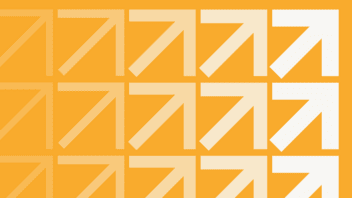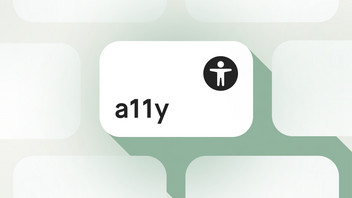A consistent brand presence, greater efficiency in design and development, and high scalability are the impressive advantages of a design system. Learn how to establish this way of working in your organization.
Creating consistency with design systems – and cutting costs
Designers and developers know the challenge: with every new product, platform, or project a company develops, the complexity grows as well. Constantly changing requirements in technology, usability, and strategy quickly make designs outdated and confusing. Without structured processes, 'Frankenstein products' emerge – disjointed patchworks of inconsistent elements.
This is where design systems come in. They provide a systematic solution by linking all elements in a logical structure and enabling global updates. Teams can access standardized building blocks in real time and collaborate more efficiently. Design systems are transforming the industry and making the traditional relaunch a thing of the past.
Interested? Our flexible design systems help streamline workflows and keep your brand consistent across every channel. Discover our services as a design system agency.
Transformative design system for STIHL
How STIHL boosts cross-departmental efficiency, creates a consistent brand experience, and reduces costs with a design system that provides all teams with shared foundations such as fundamentals, tokens, and core components across platforms.
What is a design system?
A design system is a collection of guidelines, best practices, components, and elements that enable consistent and efficient design across all teams, platforms, and products within an organization.
It serves as a central reference point for design decisions and helps define and standardize visual aesthetics, user interface behavior, and digital brand identity. In doing so, a design system supports the company’s goal of creating a seamless experience for users across all touchpoints.
Excursus: Atomic design as a methodological foundation
Brad Frost first introduced the concept of 'Atomic Design' in 2013 – a modular approach to web development inspired by the periodic table of elements. Today, this approach forms the methodological foundation for design systems.
Frost divides web design into five levels:
- Atoms: Core UI components that cannot be broken down further, such as HTML tags, form elements, and buttons.
- Molecules: Combinations of atoms that form simple UI components. For example, a label, search input, and button can be combined to create a 'search form molecule.'
- Organisms: Groups of molecules and atoms that form complex components, such as a header bar with a logo, navigation, and search field.
- Templates: Page layouts that define the placement of organisms and demonstrate structure and functionality within the layout.
- Pages: Templates that display real, representative content and variations of the user interface.
Components of a UI/UX design system
A design system encompasses every aspect of a company’s design and brand experience across platforms, products, and services. The following components are interconnected:
- Design guidelines: Rules and principles that define the design of user interfaces. They specify how fundamentals such as color, typography, grid, and motion are used and set the visual aesthetic of layout principles and UI patterns.
- Component libraries: Collections of reusable tokens, styles, and core UI components (for example, buttons, input fields, and tabs) that are consistently designed and structured according to current best practices.
- Templates & pages: Style sheets for various page types or product flows. They show the design and development teams how the developed elements can be combined. They ensure that design remains consistent across different parts of a project.
- Brand resources: Integration of brand assets such as logos, icon system, and illustrations, as well as guidelines on how to use them in context.
- Documentation: A comprehensive guide to using the design system. It includes tutorials, design and code examples, and detailed explanations for implementing design elements correctly.
- Governance: A structured process for collecting feedback from designers, developers, and other stakeholders to continuously improve the design system. This may include feedback loops, surveys, reviews, or other communication channels.
Design Systems: The invisible hero behind successful products
A design system brings numerous advantages that optimize the entire development process and improve the quality of results.
1. Consistency across products
A design system ensures a unified look and user experience across all company products and platforms. This strengthens the brand identity and builds trust among users.
2. Improved collaboration between design and development
When building a design system, designers and developers establish a shared language, clear guidelines, and structure. This speeds up daily workflows, improves communication, and minimizes misunderstandings. Designers can clearly express their vision, while developers can rely on reusable, well-documented components.
3. Greater efficiency in the development process
Reusing design modules and standardized code components significantly shortens development time. Teams can focus on innovation and cross-platform solutions instead of repeating tasks. Integrating new requirements, such as a switch to barrier-free web design, also becomes much easier.
4. Error reduction and quality improvement
Since design systems rely on tested and verified components, the risk of errors is greatly reduced. This leads to more stable, reliable products and saves time that would otherwise be spent troubleshooting.
Cost efficiency and maintenance effort – when is a design system worthwhile?
You don't get all this for free: a design system requires a considerable initial investment and ongoing maintenance. It becomes worthwhile when the time and effort saved through design and development clearly exceed those costs.
This is usually the case for projects that are large, complex, and long term, where many design elements are repeated across different products or platforms. In these scenarios, the investment quickly pays off through improved efficiency and higher quality. A well-implemented design system is therefore both a strategic and economical decision.
Do I need a design system?
Is the initial outlay for a design system in your organization worth it? Talk to us directly or simply find out with our decision flow!
The difference between a design system and a pattern library
A design system and a pattern library are both tools used to promote consistency and efficiency in user interface design. Although they share similar goals, there are fundamental differences between them:
| design system | pattern library |
|---|---|
|
1. Scope and purpose: |
|
|
A design system is a comprehensive collection of guidelines, best practices, components, and resources. It defines not only the visual design but also user interface behavior and brand identity. It serves as the central reference point for design across an entire organization or project. |
A pattern library (also known as a component library) is more specific. It focuses on reusable design patterns and components. It may be part of a design system or exist independently, concentrating solely on the reusability of design elements. |
|
2. Contents: |
|
|
In addition to one or more pattern libraries, a design system usually includes design guidelines, style templates, brand resources, and detailed documentation. |
A pattern library, on the other hand, focuses primarily on collecting and documenting individual UI components, patterns, and their variations. |
|
3. Area of application: |
|
|
A design system provides a comprehensive guideline for creating user interfaces across various applications or products within an organization. |
Depending on its purpose and scope, a pattern library may be less flexible and more application-specific. In many cases, pattern libraries contain solutions tailored to particular teams, platforms, or products that cannot be transferred universally. |
To summarize: a design system provides a comprehensive and strategic approach to managing design, while a pure pattern library focuses on the practical collection and documentation of reusable design patterns.
Nevertheless, pattern libraries are an essential part of every design system. They form the foundation in the early stages and are continuously expanded and refined throughout the development process.
Developing a design system in six steps
The process of developing a design system varies in scope and structure depending on the size of the company, its focus, and its objectives. A design system can start small and grow gradually. It’s important to involve all stakeholders from the beginning to ensure their needs are considered.
These six steps are important when developing a design system:
1. Needs analysis and goal setting
First, the existing designs, user feedback, and the company's brand guidelines are analyzed to identify the specific needs and responsibilities of individual teams. Based on these insights, the vision and long-term goals of the design system are defined.
2. Design and development
The core elements are used to determine the look and feel of the design system. These include color, typography, iconography, shape, motion, grid, and example layouts. Clear design principles are defined to guide the system as a whole. They are aligned with the brand’s values and goals, providing an overarching framework while allowing the teams the freedom to create emotional designs within their own applications. Pattern libraries are created, and reusable design components are developed from the identified core elements.
3. Documentation
Comprehensive documentation is created for the design system. It contains detailed instructions for the use of components, explanations of design principles, brand identity guidelines, CSS styles, and other relevant information.
4. Feedback, testing, and iteration
The design system is tested both internally and with real users. Feedback is gathered from different stakeholders, and continuous improvements are made based on the results to refine the system over time.
5. Implementation and training
The design system is implemented across all relevant products and platforms to ensure consistent use. Access is provided to all team members, and training and support are offered so the system can be applied effectively by designers, developers, and other stakeholders.
6. Maintenance and scaling
A design system is not regarded as a static artifact but as a framework that must be continuously maintained and updated to keep pace with changing requirements and trends. It must be ensured that the system remains scalable and aligned with the organization’s growing and evolving needs. This involves the regular addition of new components and guidelines, as well as adaptation to new platforms and products.
When maintained effectively, a well-designed system is recognized for increasing efficiency, improving consistency, and accelerating the development of new products. It is considered an essential element of a successful design strategy.
Five examples of good design systems
The following examples of well-designed design systems show how efficiency and innovation can be balanced equally.
-
1. Material Design from Google
Google's Material Design system has already undergone three major updates and was one of the first publicly available design systems. The focus is clearly on product development, with the latest UX insights and technological innovations regularly integrated into the system.
-
2. Carbon from IBM
Carbon is an open-source design system from IBM, tailored for enterprise-level applications. Its emphasis lies on modularity and data visualization across IBM’s broad portfolio of digital products.
-
3. Atlassian
Atlassian develops several collaboration platforms, such as Jira and Trello, with a strong focus on agility, flexibility, and efficiency. Its design system defines key principles for effective teamwork, prioritizing simplicity, productivity, and user-centered design.
-
4. Lightning from Salesforce
Salesforce provides cloud solutions, CRM, customer service, and automation tools, and has developed Lightning, a design system particularly valuable for building business applications.
-
5. Reshaped
Reshaped is a design system created for scalability and product development in React and Figma. It maintains a carefully balanced relationship between flexibility and structure, and includes clear, comprehensive documentation of its core components.
Important questions and answers
-
A design system is a comprehensive collection of guidelines, best practices, components, and resources used to create and maintain consistent and efficient design across an organization.
-
The most important elements of a design system include design guidelines, component libraries, templates and pages, brand resources, documentation, and governance.
-
The following key points belong on a design system checklist:
- Design language: description of the visual and interaction language
- Foundations: basic design elements and tokens
- Core components: component library
- Maintenance and governance: feedback and support processes
-
The difference between a design system and a pattern library lies in their scope and function. While a design system offers a comprehensive, strategic approach to managing design, a pattern library focuses on the practical collection and documentation of reusable design patterns.
-
The development of a design system takes place through several iterative steps. After the goals are defined, potentials are identified, elements are determined, and design principles are established. Pattern libraries are then built, and components are created. Next, documentation is produced, the design system is tested, and finally implemented. Continuous maintenance and updates, as well as the training and support of stakeholders and teams, are also essential parts of developing a design system that functions effectively in the long term.
-
Companies with multiple brands can develop a global design system that serves as a foundation for all brands. With modern headless design systems using tokens and themes, the same components and templates can be deployed across different brand identities. The structure, functionality, and component requirements must remain consistent across brands. When implemented successfully, this approach can lead to exponential cost savings in development.
Would you like to know more? Then please get in touch.
Thank you!
We’ll get back to you as soon as possible.


















